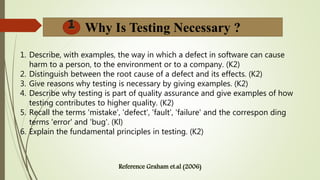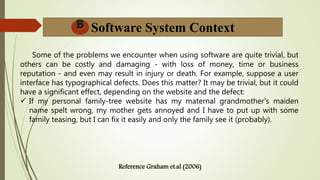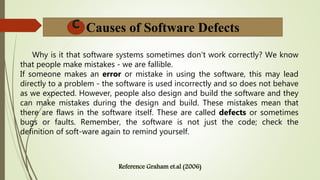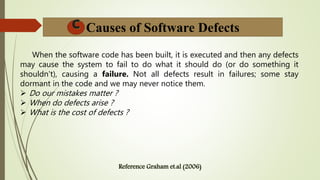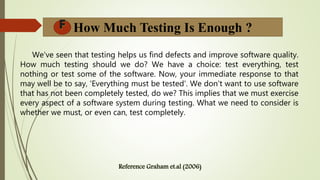Fundamentals of testing why is testing necessary (reference graham et.al (2006))
- 2. Why Is Testing Necessary ? 1. Describe, with examples, the way in which a defect in software can cause harm to a person, to the environment or to a company. (K2) 2. Distinguish between the root cause of a defect and its effects. (K2) 3. Give reasons why testing is necessary by giving examples. (K2) 4. Describe why testing is part of quality assurance and give examples of how testing contributes to higher quality. (K2) 5. Recall the terms 'mistake', 'defect', 'fault', 'failure' and the correspon ding terms 'error' and 'bug'. (Kl) 6. Explain the fundamental principles in testing. (K2)
- 3. Introduction In this section, we're going to kick off the book with a discussion on why testing matters. We'll describe and illustrate how software defects or bugs can cause problems for people, the environment or a company. We'll draw important dis-tinctions between defects, their root causes and their effects. We'll explain why testing is necessary to find these defects, how testing promotes quality, and how testing fits into quality assurance. In this section, we will also introduce some fundamental principles of testing. As we go through this section, watch for the Syllabus terms bug, defect, error, failure, fault, mistake, quality, risk, software, testing and exhaustive testing. You'll find these terms defined in the glossary.
- 4. Software System Context Some of the problems we encounter when using software are quite trivial, but others can be costly and damaging - with loss of money, time or business reputation - and even may result in injury or death. For example, suppose a user interface has typographical defects. Does this matter? It may be trivial, but it could have a significant effect, depending on the website and the defect: If my personal family-tree website has my maternal grandmother's maiden name spelt wrong, my mother gets annoyed and I have to put up with some family teasing, but I can fix it easily and only the family see it (probably).
- 5. Software System Context If the company website has some spelling mistakes in the text, potential cus tomers may be put off the company as it looks unprofessional. If a software program miscalculates pesticide application quantities, the effect could be very significant: suppose a decimal point is wrongly placed so that the application rate is 10 times too large. The farmer or gardener uses more pesticide than needed, which raises his costs, has environmental impacts on wildlife and water supplies and has health and safety impact for the farmer, gardener, family and workforce, livestock and pets. There may also be consequent loss of trust in and business for the company and possi ble legal costs and fines for causing the environmental and health problems.
- 6. Causes of Software Defects Why is it that software systems sometimes don't work correctly? We know that people make mistakes - we are fallible. If someone makes an error or mistake in using the software, this may lead directly to a problem - the software is used incorrectly and so does not behave as we expected. However, people also design and build the software and they can make mistakes during the design and build. These mistakes mean that there are flaws in the software itself. These are called defects or sometimes bugs or faults. Remember, the software is not just the code; check the definition of soft-ware again to remind yourself.
- 7. Causes of Software Defects When the software code has been built, it is executed and then any defects may cause the system to fail to do what it should do (or do something it shouldn't), causing a failure. Not all defects result in failures; some stay dormant in the code and we may never notice them. Do our mistakes matter ? When do defects arise ? What is the cost of defects ?
- 8. Role of Testing in Software Development, Maintenance and Operations We have seen that human errors can cause a defect or fault to be introduced at any stage within the software development life cycle and, depending upon the consequences of the mistake, the results can be trivial or catastrophic. Rigorous testing is necessary during development and maintenance to identify defects, in order to reduce failures in the operational environment and increase the quality of the operational system. This includes looking for places in the user interface where a user might make a mistake in input of data or in the interpretation of the output, and looking for potential weak points for intentional and malicious attack.
- 9. Executing tests helps us move towards improved quality of product and service, but that is just one of the verification and validation methods applied to products. Processes are also checked, for example by audit. A variety of methods may be used to check work, some of which are done by the author of the work and some by others to get an independent view. Role of Testing in Software Development, Maintenance and Operations
- 10. Testing and Quality Testing helps us to measure the quality of software in terms of the number of defects found, the tests run, and the system covered by the tests. We can do this for both the functional attributes of the software (for example, printing a report correctly) and for the non-functional software requirements and characteristics (for example, printing a report quickly enough). Non-functional characteristics are covered in Chapter 2. Testing can give confidence in the quality of the soft-ware if it finds few or no defects, provided we are happy that the testing is suf-ficiently rigorous. Of course, a poor test may uncover few defects and leave us with a false sense of security.
- 11. A well-designed test will uncover defects if they are present and so, if such a test passes, we will rightly be more confident in the software and be able to assert that the overall level of risk of using the system has been reduced. When testing does find defects, the quality of the software system increases when those defects are fixed, provided the fixes are carried out properly. Testing and Quality
- 12. We've seen that testing helps us find defects and improve software quality. How much testing should we do? We have a choice: test everything, test nothing or test some of the software. Now, your immediate response to that may well be to say, 'Everything must be tested'. We don't want to use software that has not been completely tested, do we? This implies that we must exercise every aspect of a software system during testing. What we need to consider is whether we must, or even can, test completely. How Much Testing Is Enough ?
- 13. “THANK YOU”

